View in other NatureServe Network Field Guides
NatureServe
Montana
Utah
Wyoming
Idaho
Wisconsin
British Columbia
South Carolina
Yukon
California
New York
Giant Helleborine - Epipactis gigantea
State Rank Reason (see State Rank above)
Known from several dozen occurrences across western and southern Montana where it is associated with seeps and springs, fens, and thermal waters. Several sites are likely extirpated, while others are known only from historical collections. National Forest, state and private lands all host significant populations. The species is primarily vulnerable to hydrologic changes and development.
- Details on Status Ranking and Review
Population Size
Score1-2 - Small to Moderate. Population size is imprecisely known but is believed to be >2,000 individuals and <100,000 individuals.
CommentBased upon available estimates at known populations, it appears likely that total population in Montana is > 10,000 plants though estimates are too imprecise to be certain.
Range Extent
Score1 - Peripheral, Disjunct or Sporadic Distribution in MT: Widespread species that is peripheral, disjunct or sporadically distributed within MT such that it occurs in <5% of the state (<7,500 sq. miles or the combined area of Beaverhead and Ravalli Counties) or is restricted to 4-5 sub-basins.
Area of Occupancy
Score1 - Moderate: Generally occurring in 11-25 Subwatersheds (6th Code HUC’s).
Environmental Specificity
Score2 - High: Species is restricted to a highly specialized and limited habitat and is typically dependent upon unaltered, high-quality habitat (C Values of 8-10).
Trends
Score1-2 - Minor to Moderate Declines:
CommentTrend data are largely unavailable though small declines have likely taken place or can be expected to occur in the near future.
Threats
Score1-2 - Medium to High.
CommentSome populations near roadsides or at warm springs have a high potential to be negatively impacted.
Intrinsic Vulnerability
Score2 - High Vulnerability: Very specific biological attributes, unusual life history characteristics or limited reproductive potential makes the species highly susceptible to extirpation from stochastic events or other adverse impacts to its habitat and very slow to recover.
Raw Conservation Status Score
Score
9 to 12 total points scored out of a possible 19.
General Description
PLANTS: Perennial herbs with leafy stems that are 30-120 cm tall and which arise from short rhizomes to form colonies. Source: Lesica et al. 2012.
LEAVES: The leaves are cauline, without petioles clasping the stem, and up to 20 cm long. Lower leaves are ovate while the upper are lance-shaped. The herbage is rough to the touch or smooth and glabrous. Source: Lesica et al. 2012.
INFLORESCENCE: A long, narrow, 4-10 flowered, leafy-bracted raceme located at the tops of the stems. Flowers are bilaterally symmetrical with long green sepals and shorter, broader, reddish petals. Source: Lesica et al. 2012.
The specific epithet gigantea translates directly to the common name “giant” and refers to the large size of the species when compared to other species in the genus. Epipactis is derived from the ancient Greek word epipaktis which was the common name for hellebore, a genus in the Ranunculaceae family that bears some similarities to Epipactis species (Giblin et al. [eds.] 2018).
Phenology
Range wide, Epipactis gigantea flowers anywhere from March through August (Brown et al. 2002). The flowering period of cooler climates may not begin until mid-June (Rocchio et al. 2006).
Diagnostic Characteristics
Montana has two species of
Epipactis, one native,
E. gigantea, and one non-native,
E. helleborine. Both species are perennial herbs with bilaterally symmetrical flowers borne in leafy-bracted terminal racemes.
Giant Helleborine -
Epipactis gigantea, native, SOC
*Size: Mature plants are 30-120 cm tall.
*Leaves: Lanceolate to elliptic blades that are 6-15 cm long.
*Sepals: Green with obvious brown veins. Lateral sepals are 12-24 mm long.
*Petals: Lateral petals 13-15 mm long, ovate, and pinkish.
*Lip: Lip petal 14-20 mm long, concave, and grooved on the tip (lobed). Petal is orangish-yellow with a saccate portion that is purplish veined.
*Fruit: An ovoid to ellipsoid capsule, glabrate, that is 2-3 cm long.
Eastern Helleborine -
Epipactis helleborine, exotic
*Size: Mature plants are 20-100 cm tall.
*Leaves: Lanceolate to ovate blades that are 6-10 cm long.
*Sepals: Green with no or very faint brown veins. Lateral sepals are 6-13 mm long.
*Petals: Lateral petals 8-11 mm long, ovate, and pinkish.
*Lip: Lip petal 9-12 mm long, pouch-like, and not grooved on the tip (not lobed). Petal is purplish-green with saccate portion that is purplish and indistinctly veined.
*Fruit: An ellipsoid capsule that is 9-14 mm long.
Species Range
Montana Range
Range Descriptions
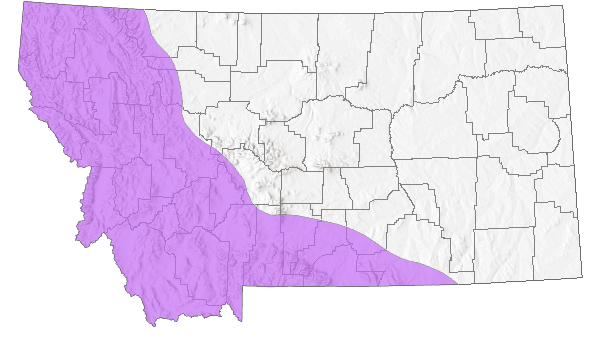
 Native
Native
Range Comments
This species occurs from British Columbia south to California, Arizona, New Mexico, Texas, and Mexico (Lesica et al. 2012).
Observations in Montana Natural Heritage Program Database
Number of Observations: 138
(Click on the following maps and charts to see full sized version)
Map Help and Descriptions
Relative Density
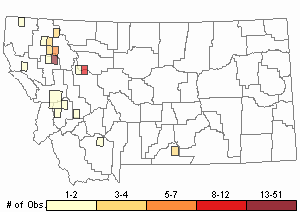
Recency

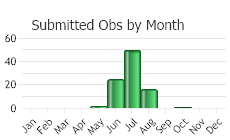
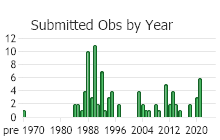
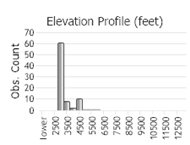 (Observations spanning multiple months or years are excluded from time charts)
(Observations spanning multiple months or years are excluded from time charts)
Habitat
Giant Helleborine prefers saturated, calcareous soil of often warm seeps and springs where the ground doesn’t freeze hard, in valleys (Lesica et al. 2012).
Preferred habitat includes hot springs and lake shores (Mehrhoff 1978).
National Vegetation Classification System Groups Associated with this Species
Wetland and Riparian
Peatland
Riparian and Wetland Forest
Ecology
ASSOCIATED SPECIES
Giant Hellborine’s wide elevational range and ability to occur in a variety of different wetland and riparian plant community types means that it possesses a long list of known plant associations (Rocchio et al. 2006). Giant Hellborine is known to occur in riparian plant communities dominated by cottonwood (Populus spp.), willow (Salix spp.), and River Birch (Betula occidentalis). In seep and spring habitats, it occurs in locations dominated by Creeping Spikerush (Eleocharis rostellata) and River Birch. Sedges (Carex spp.) are one of the most commonly assocated plant groups.
ENVIROMENTAL FACTORS AND FLOWERING SUCCESS
Biotic and abiotic factors both contribute to the flowering and fruiting success of Giant Helleborine. A study of Montana fens revealed much lower (56.7 percent drop) fruiting success on a year that exhibited higher than average precipitation events during the blooming period, which could have led to fewer pollinator visits (Mantas 1993). While precipitation, temperature, pollinators, plant communities, and soil conditions changed drastically both spatially and temporally, the probability of seedlings maturing into flowering plants remained low at 5 percent or less.
MYCORRHIZAL FUNGI
Seeds of Giant Helleborine require the presence of mycorrhizal fungi in order to germinate and develop a protocorm (Rocchio et al. 2006). Mycorrhizal fungi make nutrients available that Giant Helleborine cannot obtain otherwise. Based on a study conducted at a mining site, mycorrhizal fungi associated with the roots of Epipactis atrorubens were observed filtering unwanted heavy metals out of water and nutrients absorbed from the soil by plants (Jurkiewicz 2001). A similar relationship may exist with other Epipactis species.
POLLINATION
Since Giant Helleborine offers nectar as a reward for pollination, it may be visited by many unspecialized species of pollinators (Nilsson 1981). The genus has also been referred to as wasp-pollinated (Burns-Balogh et al. 1986).
Like many members of Orchidaceae, E. gigantea has developed a specialized relationship with an insect pollinator, in this case, Syrphid flies (Rocchio et al. 2006). Plants attract flies by mimicking the honeydew scent of aphids, which occur in masses and are what Syrphids typically lay their eggs upon (Argue et al. 2012). When flies land on the labellum of the flower, it picks up pollinia which it then transfers to the next flower.
In the first year of a Montana based study on the reproductive success of Giant Helleborine, common yellow jackets were observed as pollinators (Mantas 1993). However, in the second year of the study yellow jackets were not observed at the study sites and a drop in fruiting success was detected. It was theorized that the abnormally rainy weather early on in the flowering season could have been responsible for less active pollinators, and thus reduced fruit development.
HERBIVORY
In a Montana study, ungulates, insects, and slugs were found to feed on Giant Helleborine (Mantas 1993). Slugs were identified as the primary herbivore but caused no significant damage at most sites. However, one slug in the genus Zacoleus was found to cause damage to the leaves, but only at one site. Furthermore, browsing by this species, while common on the leaves, did not appear to impact the flowering success of the plants. Damage by ungulates and insects was determined to be minor.
Reproductive Characteristics
FLOWERS
The lance-shaped sepals are green with brownish stripes and approximately 15 mm long. The upper two petals are shorter and broader than the sepals. The lower petal is sac-like and longer and more reddish than the sepals.
FRUIT
Mature fruit are 2-2.5 cm long capsules. The nodding capsule is elliptic and bears many thousands of tiny seeds.
LIFE CYCLE
After germination, seeds develop a protocorm before maturing into seedlings. This protocorm develops root hairs and eventually a leafy shoot (Rocchio et al. 2006). It may take anywhere from 2.5 to 12 months for the seeds to germinate and develop a protocorm and them another 3 to 18 months for the leafy shoot to emerge above ground (Dressler 1981). Adult plants flower and reproduce by rhizomes through the growing season. Epipactis species also have to ability to colonize an area via lateral shoots. Once foliage dies back, the rhizomes become dormant through the winter (Rocchio et al. 2006).
VEGETATIVE REPRODUCTION
Giant Helleborine is a clonal species. Reproduction occurs through short, fibrous rhizomes that are usually severed from parent plant within one season (Thornhill 1996). Seedlings are much less commonly seen than these clonal raments (Rocchio et al. 2006).
Management
Conservation measures that protect habitat’s hydrological regime will maintain Giant Helleborine populations for the long-term (Roccio et al. 2006). Necessary conservation measures that function at the landscape level include limiting threats to groundwater withdrawal and stream-flow alteration (Rocchio et al. 2006). Other measures may include limiting impacts from recreation and grazing, though plants may be more tolerant of these activities (Rocchio et al. 2006).
The distance of an individual from the edge of a fen alters its location’s edge environment, water table depth, and water chemistry (Mantas 1993). Characteristics associated with the edges of suitable habitat have the greatest effects on vigor and fitness of Giant Helleborine. These effects should be taken into account when considering habitat alteration.
Stewardship Responsibility
Threats or Limiting Factors
Across its range various threats have been reported in the literature. These types of threats may influence or compound the effects of one another:
*Recreation, invasive species, water development, grazing impacts, urban development, and timber harvest are the primary threats to Giant Helleborine (Rocchio et al. 2006).
*A fungal pathogen that kills flowering buds was found in Montana (Mantas 1993). The fungus was found to be widespread at sites within the Montana study, yet occurred on very few raments and did not kill infected individuals.
*Giant Helleborine has a preference for hot springs and lakeshore habitats which can make the species more vulnerable to exploitation by recreators (Mehrhoff 1978).
STATE THREAT SCORE REASON
Reported threats to Montana's populations of Giant Helleborine are those that negatively impact its habitat in saturated substrates of fens, seeps, and warm and hot springs (MTNHP Threat Assessment 2021). Noxious weeds including Spotted Knapweed (Centaurea stoebe), Canada Thistle (Cirsium arvense), and Ox-eye Daisy (Leucanthemum vulgare) are established at some populations, usually co-occurring with other threats. Chemical herbicide used to control noxious weed invasions poses an additional risk and is the primary factor responsible for the loss of one population. Other threats are directed at the hydrological requirements of Giant Helleborine. One population was damaged at a site by human-caused water alterations (damming or diverting). Another population occurs at a privately-owned thermal spring where the risk of development is a concern. Information on the scope, severity, and/or timing of existing threats to Giant Helleborine is needed.
References
- Literature Cited AboveLegend:
 View Online Publication
View Online Publication Lesica, P., M.T. Lavin, and P.F. Stickney. 2012. Manual of Montana Vascular Plants. Fort Worth, TX: BRIT Press. viii + 771 p.
Lesica, P., M.T. Lavin, and P.F. Stickney. 2012. Manual of Montana Vascular Plants. Fort Worth, TX: BRIT Press. viii + 771 p. MTNHP Threat Assessment. 2021. State Threat Score Assignment and Assessment of Reported Threats from 2006 to 2021 for State-listed Vascular Plants. Botany Program, Montana Natural Heritage Program, Helena, Montana.
MTNHP Threat Assessment. 2021. State Threat Score Assignment and Assessment of Reported Threats from 2006 to 2021 for State-listed Vascular Plants. Botany Program, Montana Natural Heritage Program, Helena, Montana.
- Additional ReferencesLegend:
 View Online Publication
View Online Publication
Do you know of a citation we're missing? Allen, D.R. 1982. Epipactis gigantea. American Orchid Society Bulletin 51(10): 1038-1040.
Allen, D.R. 1982. Epipactis gigantea. American Orchid Society Bulletin 51(10): 1038-1040. Berg, Ken, and Roxanne Bittman. 1988. Rediscovery of the Humboldt milk-vetch. Fremontia. 16(1):13-14.
Berg, Ken, and Roxanne Bittman. 1988. Rediscovery of the Humboldt milk-vetch. Fremontia. 16(1):13-14. Brunton, D.F. 1986. Status of the giant helleborine, Epipactis gigantea (Orchidaceae), in Canada. The Canadian Field-Naturalist 100(3): 414-417.
Brunton, D.F. 1986. Status of the giant helleborine, Epipactis gigantea (Orchidaceae), in Canada. The Canadian Field-Naturalist 100(3): 414-417. Burns-Balogh, P., D. L. Szlachetko, and A. Dafni. 1987. Evolution, pollination, and systematics of the tribe Neottieae (Orchidaceae). Plant Systematics and Evolution 156: 91-115.
Burns-Balogh, P., D. L. Szlachetko, and A. Dafni. 1987. Evolution, pollination, and systematics of the tribe Neottieae (Orchidaceae). Plant Systematics and Evolution 156: 91-115. Idaho Native Plant Society. 1993. Federal candidate (C1 and C2) and listed rare plants of Idaho. unpaginated.
Idaho Native Plant Society. 1993. Federal candidate (C1 and C2) and listed rare plants of Idaho. unpaginated. Lesica, P. 1990. Vegetation and sensitive plant species of wetlands associated with geothermal areas in the greater Yellowstone ecosystem in Montana. Unpublished report on file at the Montana Field Office, The Nature Conservancy, Helena. 9 pp.
Lesica, P. 1990. Vegetation and sensitive plant species of wetlands associated with geothermal areas in the greater Yellowstone ecosystem in Montana. Unpublished report on file at the Montana Field Office, The Nature Conservancy, Helena. 9 pp. Lesica, P., M.T. Lavin, and P.F. Stickney. 2022. Manual of Montana Vascular Plants, Second Edition. Fort Worth, TX: BRIT Press. viii + 779 p.
Lesica, P., M.T. Lavin, and P.F. Stickney. 2022. Manual of Montana Vascular Plants, Second Edition. Fort Worth, TX: BRIT Press. viii + 779 p. Mantas, M. 1993. Ecology and reproductive biology of Epipactis gigantea Dougl. (Orchidaceae) in northwestern Montana. M.S. thesis. University of Idaho. 73 pp.
Mantas, M. 1993. Ecology and reproductive biology of Epipactis gigantea Dougl. (Orchidaceae) in northwestern Montana. M.S. thesis. University of Idaho. 73 pp. Rare and Endangered Plants Technical Committee, Idaho Natural Areas Council. 1981. Vascular Plant Species of Concern in Idaho. University of Idaho, College of Forestry, Wildlife and Range Sciences, Bulletin No. 34. 161 pp.
Rare and Endangered Plants Technical Committee, Idaho Natural Areas Council. 1981. Vascular Plant Species of Concern in Idaho. University of Idaho, College of Forestry, Wildlife and Range Sciences, Bulletin No. 34. 161 pp. Schassberger, L.A . 1988. Status review of Epipactis gigantea, USDA Forest Service, Region 1, Flathead National Forest. Unpublished report. Montana Natural Heritage Program, Helena, MT 42 pp.
Schassberger, L.A . 1988. Status review of Epipactis gigantea, USDA Forest Service, Region 1, Flathead National Forest. Unpublished report. Montana Natural Heritage Program, Helena, MT 42 pp. Vanderhorst, J.P. and B.L. Heidel. 1995. Sensitive plant survey in the Tobacco Root Mountains, Madison County, Montana. Unpublished report to the Beaverhead and Deerlodge National Forests. Montana Natural Heritage Program. Helena, MT. 66 pp. plus appendices.
Vanderhorst, J.P. and B.L. Heidel. 1995. Sensitive plant survey in the Tobacco Root Mountains, Madison County, Montana. Unpublished report to the Beaverhead and Deerlodge National Forests. Montana Natural Heritage Program. Helena, MT. 66 pp. plus appendices. Vij, S. P. and G. C. Gupta. 1975. Cytological investigations into W. Himilayan Orchidaceae 1. Chromosome numbers and karyotypes of taxa from Kashmir. Cytologia 40:613-621.
Vij, S. P. and G. C. Gupta. 1975. Cytological investigations into W. Himilayan Orchidaceae 1. Chromosome numbers and karyotypes of taxa from Kashmir. Cytologia 40:613-621.
- Web Search Engines for Articles on "Giant Helleborine"





